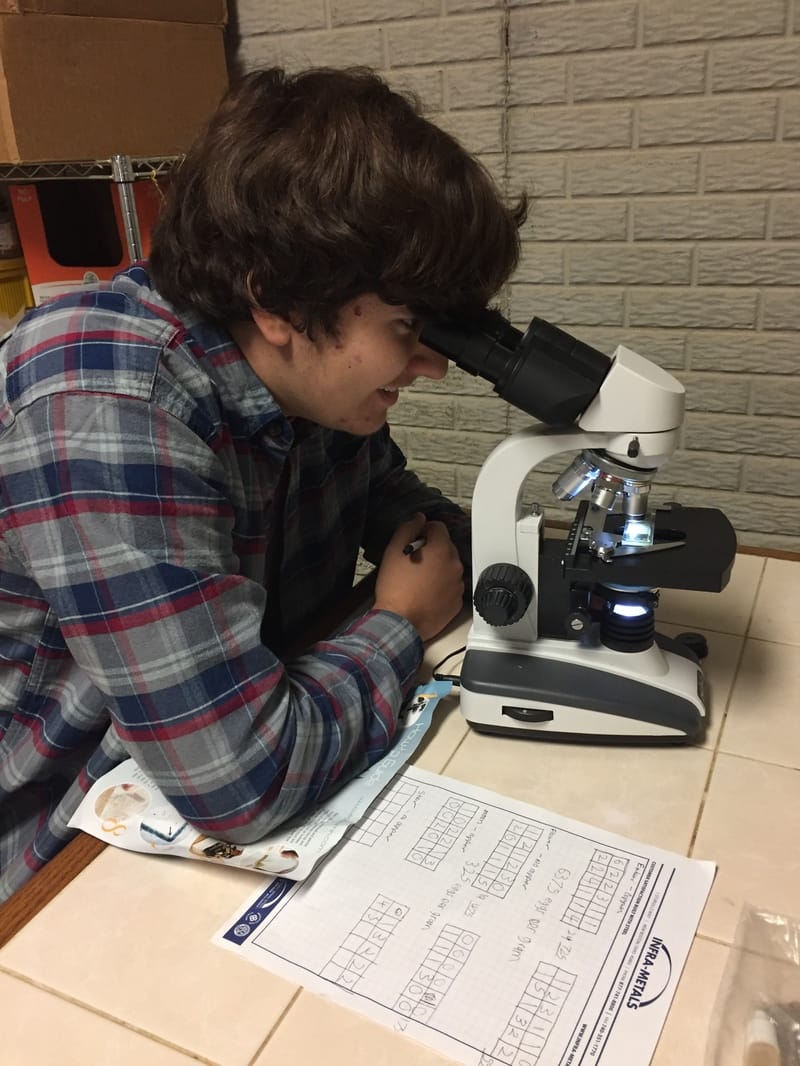|
Its that time of year again, Science Fair. While I would not consider Connor or myself mad scientists, or even lab rats, we have learned a few things about using a microscope to examine livestock feces. I wanted to share our experiment and results because it may be of interest to my fellow goat lovers. Last year we conducted a similar experiment with sheep, Our hypothesis was: If copper bolus treatment is given to goats, then their fecal egg counts will decrease. We conducted the test in two steps. First, we randomly selected 4 goats to recieve Copper Oxide Wire Particle bolus and 4 who would not recieve copper or any other medication. We used the recommended dosage of 4 Gm/ 100 pounds, and administered using a bolus injector to the back of the throat then held their mouth closed and encouraged swallowing. At the same time, we conducted a FAMACHA examination of their eyelids, and obtained a fecal sample from each goat. We prepared our samples and viewed each under the microscope, counting eggs and documenting each carefully. We prepared two slides for each goat sample and took an average of the two as our final result. Two weeks later, we repeated the examinations and compared our results. The goats in the control group were administered COWP this time for good measure.
Our results were as follows: Each goat who recieved COWP with the initial testing had a reduction in fecal egg count two weeks later. Goat 1 - 37.3 % reduction Goat 2 - 2.44% reduction Goat 3 - 82.6% reduction Goat 4 - 24.14% reduction Average reduction - 35% Goats who did not recieve COWP initially, two had an increase in Fecal egg count, and two had very minimal reductions in fecal egg count. While this is not earth shattering information, it confirms the benefits and importance of Copper in the health of goats, and reinforces to me the importance of maintaining a regular treatment schedule for copper. Keep in mind this test was conducted in November when goats are off pasture and typically have lower worm loads due to eating hay and not browse. All of their FAMACHA scores were within a 2 - 3 range, and no one was denied a necessary treatment. His Abstract gives the Readers Digest version for those who are interested: "Haemonchus contortus, barber pole worm, is the main concern of many goat producers. Management through anthelmintics has become marginal due to parasitic resistance to most common dewormers used throughout the United States today. Additional methods, including copper oxide wire particles, or COWP, have proven to be highly effective in reducing worm counts of small ruminants. The U.S. department of Agriculture found that ingested COWP particles are a way to control barber pole worms. They found that doses as low as ½ gram reduced nematodes b 60-90% for at least four weeks. The exact mechanism of COWP is not fully understood. Researchers believe copper has a direct effect on the internal parasites. It may also help to boost the immune system of the animal. Many goat producers in the southern Ohio area struggle with internal parasites and finding the best treatment. This experiment was conducted to see if the copper bolus treatment method is effective. It is believed that if a sample of goats is given copper, then their fecal egg count would decrease more than those of goats that had not been treated with anything. Using the McMaster FEC method and standard equipment, tests shall determine substantial reduction in fecal egg counts in treated animals. After testing, it was determined treated animals showed a 35% average reduction in fecal egg count. In conclusion, the hypothesis was confirmed and copper oxide particles contribute to a reduction in fecal egg count. The results of this experiment can be applied to responsible care and management of goats. Along with other preventative measures, goat keepers may safely utilize COWP in prescribed amounts on a regular basis to assist in the control of barber pole worm."
4 Comments
Carmen
1/3/2017 09:19:35 pm
No one blogged about my science fair projects (all which were not as cool).
Reply
1/4/2017 06:24:07 am
I think it was a great study. I have used them fro a few years. Way to go
Reply
Liz
1/4/2017 06:42:16 am
Very, very useful findingS. Ur son did a great job.
Reply
L Long
1/8/2017 04:13:21 am
Good work! Thanks for sharing. It's nice to know our herd care is validated.
Reply
Leave a Reply. |
AuthorMy name is Christy Franklin. Archives
February 2021
Categories |

 RSS Feed
RSS Feed
